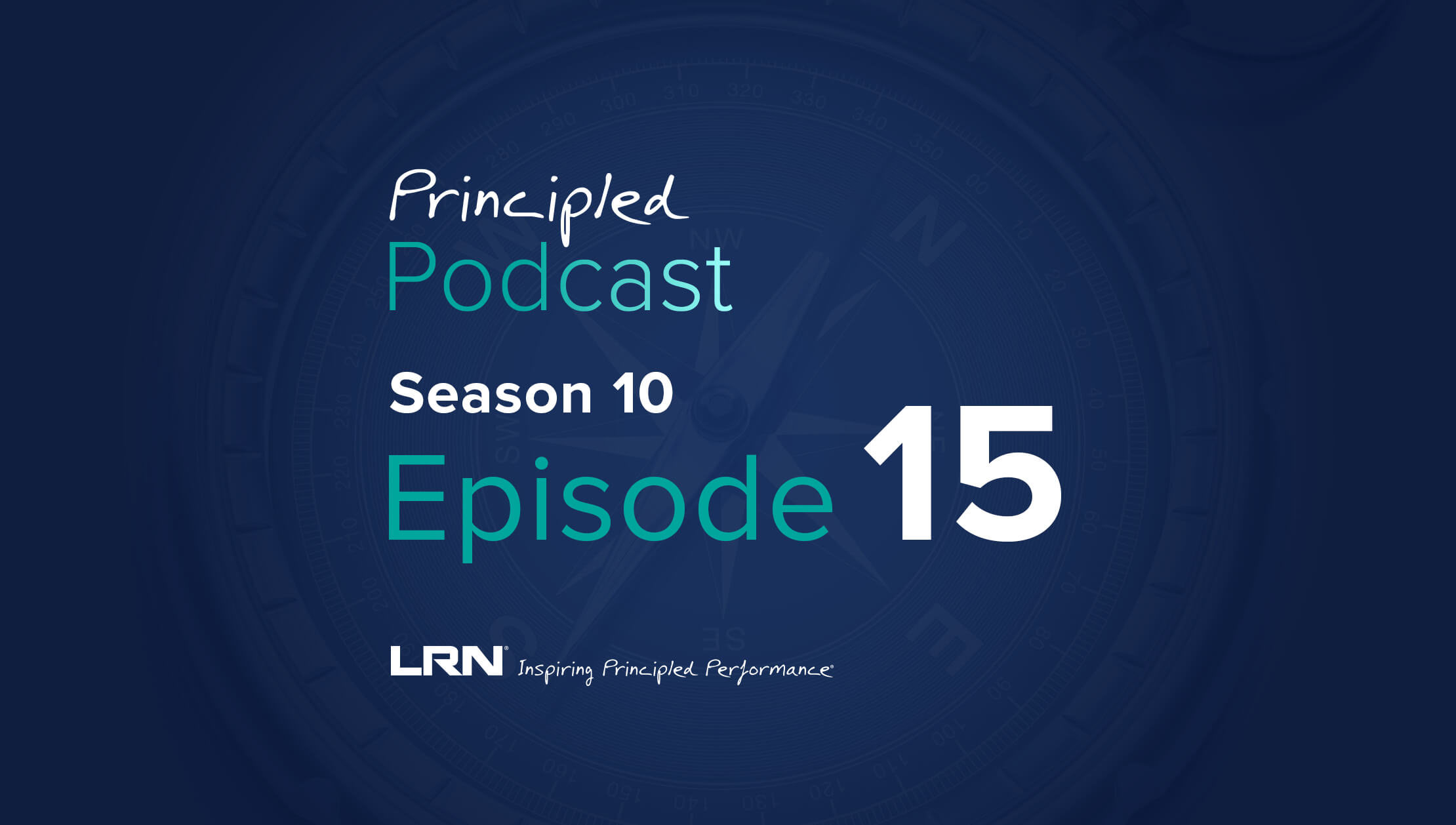We had the pleasure of speaking with Patricia Harned, Ph.D., about the new Global Business Ethic Survey, which explores workplace conduct through the lens of employees. Dr. Harned is CEO of the Ethics & Compliance Initiative (ECI), a nonprofit alliance that empowers organizations to build and sustain high quality ethics and compliance (E&C) programs, that fields the survey and analyzes the results.
Dr. Harned, who oversees all of ECI’s strategy and operations, advises senior leaders on effective ways to build an ethical culture and promote integrity in organizational activities. She chaired ECI’s Blue Ribbon Panel on High-Quality Ethics & Compliance Programs, which established a new industry standard for effective ethics and compliance efforts in organizations.
Please read on for our full interview with Dr. Harned.
Over the 27 years of the Global Business Ethics Survey (GBES), what would you say are the biggest changes in the perception, practice, and influence of ethics and compliance on an organization?
Dr. Harned: We first implemented the Global Business Ethics Survey research at a time when E&C looked very different in organizations. In 1994, a comprehensive E&C program involved implementing a code of conduct, training on organizational values, and a hotline for receiving reports of wrongdoing. Not many organizations were even doing those 3 things – back then only 60% of employees worked in organizations with just a code.
Suffice it to say that perceptions and practice have changed a great deal since that time. Not only has the GBES research been able to highlight the growth of E&C program implementation in organizations; the findings have also revealed that there is a 467% difference in the impact that E&C makes, depending on the quality of the effort.
We’ve also learned about the incredible importance of culture in influencing conduct. For example, when an organization builds a strong ethical culture – where core values and company standards are taken seriously – there is a 546% increase in good conduct by employees. That includes measures like feeling less pressure to compromise standards, willingness to report suspected wrongdoing, and trusting management.
Finally, to me one of the biggest insights that has come from the GBES body of work has to do with the reporting patterns of employees once they observe misconduct. In the early days of the research, practitioners assumed that hotline reports were the most accurate measure of wrongdoing in an organization because we believed that the majority of reports are captured that way. However, we have since learned that nothing could be farther from the truth. In fact, only a fraction of reports (less than 5%) are received through a hotline. The majority of employees tell their immediate supervisor or another member of management about observed misconduct, which in many organizations does not get tracked alongside hotline reports. That insight was a game changer for a lot of organizations, as they realized that they need to supplement their hotline efforts with resources for supervisors, and to also begin tracking reports coming from managers.
The 2020 survey was done during COVID-19 – how did that change anything, either in the collection of responses, or the responses themselves?
Dr. Harned: The GBES study is implemented online and it does not appear to us that the onset of the pandemic affected employees’ willingness to participate in the study. That said, COVID-19 did affect the answers that people gave when taking the survey itself. We learned that 44% of employees feel more work-related pressure than prior to the pandemic, and half of all employees have had some sort of change in their work status. This is concerning because we have also found over the years that the more employees experience transitions in their workplace, the more likely they are to observe wrongdoing around them.
In the U.S., there was a bit of a dichotomy in the results from the GBES. Culture strength reached one of its high points in 2020 and employees were more likely to report misconduct than they were in 2017. At the same time, workers said they felt more pressure to compromise the organization’s ethical standards and reported the most retaliation they’ve experienced from reporting misconduct since 2017. What do you think accounts for this disparity?
Dr. Harned: The differences actually highlight the complex nature as to the way E&C programs work, and also the very difficult times in which we are operating. The GBES study has shown that one of the most important outcomes of an E&C program is that it helps to strengthen ethical culture. So that is likely the reason that we saw culture strength remain at a consistent level this past year. While many companies may have streamlined their E&C efforts due to economic strain, they did not eliminate them. Another outcome of an E&C program is employee reporting, which rose remarkably in 2020. This is likely due to the fact that more employees say that their organizations have implemented effective E&C programs.
ECI expected that pressure would rise substantially in 2020, in large part due to COVID-19. The data supported that hypothesis. There has been a lot going on in the world around us, as well as in our workplaces, and in our homes. So it’s not surprising that more people reported that they feel pressure to cut corners as well.
Prior GBES reports have revealed that there is an inverse relationship between reporting and retaliation. The more people report, the more likely they are to experience retaliation for having done so. Given that, ECI believes that the significant rise in retaliation over the last decade is due to increased rates of reporting and to improved employee awareness about what constitutes retaliation.
What does all this say about where we are in terms of E&C maturity?
Dr. Harned: There is encouraging news with regard to E&C program maturity, in two ways. First, as a field, we are advancing our practice because we have a deeper understanding of what it looks like to implement and mature and E&C program. In the 2016 GBES, ECI was able to show that E&C programs do actually mature, and the benefits are significant when that happens in terms of culture strength and reduction of risk. This year, we are seeing indications that more organizations have mature E&C programs around the world. Eighteen percent of top managers said that their organization has a mature E&C program in place. But that said, while the trend is encouraging, 18% is far too low. We still have a ways to go as an industry.
There also was some interesting findings in regard to perceptions about pressure and retaliation and an employee’s level in the organization. Top managers said they worked in strong ethical cultures while also being more likely to report pressure, observed misconduct, and retaliation for reporting wrongdoing. What is driving that? What did you find most interesting here?
Dr. Harned: In any given time period, top managers have tough jobs. However, in 2020 at the time that the GBES was fielded, senior leaders indicated that their organizations were contending with dramatic shifts in their workplaces due to the onset of COVID-19, in addition to the economic pressures that resulted. While not directly asked in the GBES survey, we also know that the social justice movement, increased pressure from investors and the workforce around human rights, climate change and governance also added stress. In other words, those in management positions arguably faced bigger challenges this past year than ever before in the years of the GBES research. The end result is that top managers indicated that they felt more pressure than ever to skirt the rules in order to achieve performance goals. The same was true for middle managers and first-line supervisors.
It is also the case that there tend to be differences in responses about observed misconduct, reporting, and retaliation by management level. The higher the level of employee in an organization, the more likely it is that he/she/they will indicate that the culture is strong. Higher levels of managers are also more likely to observe wrongdoing, which could be a measure of their recognition of conduct that actually constitutes a violation. The GBES research has also consistently shown over the years that top- and middle-managers are more likely to report observed misconduct. ECI believes that this, too, could be due to the fact that the higher one is in an organization, the more likely it is that he/she/they are aware of the reporting process. We know from historic GBES research that the more employees understand what happens when they come forward to report suspected wrongdoing, the more likely they are to actually step forward to raise a concern.
What are the best next steps for improving culture and tamping down the pressure to compromise standards and retaliate? What role does E&C need to play in this effort? What is the board’s role?
Dr. Harned: The answer to this question largely depends on where an organization is in terms of the maturity of its E&C program. So, the first step for any organization is to assess both the design and impact of its E&C program, and also to assess its culture in order to understand its strengths and weaknesses. From there, it is more feasible to identify priorities and next steps.
That said, GBES has instructed us over the years that several priorities are essential if organizations are to move the needle in terms of culture strength, pressure, and retaliation. The first is the commitment of senior leaders – starting with the board – to the idea that ethics is central to business strategy. The board should clearly articulate to management that building and sustaining a strong ethical culture is a priority, and the board should also regularly ask for updates and benchmarks as to the well-being of that effort. Senior leaders must also understand and accept their role in building and sustaining a strong ethical culture, and to that end the organization should put into place performance metrics to ensure that ethical conduct and “setting a proper tone” are part of the definition of successful leadership performance.
There are a number of other key steps that organizations should take. One is to communicate in as many ways possible, as frequently as possible, that employee reporting of suspected wrongdoing is encouraged, protected, and rewarded. Another is for the organization to ensure that every employee who reports receives a response, and that violators of organizational standards are held accountable.
ECI has found through the GBES that the more these kinds of activities are “owned” by leaders across the enterprise, and the more they are integrated throughout a business, the higher the likelihood that the organization will establish a strong culture where pressure is significantly reduced and retaliation is greatly diminished.



